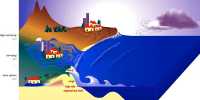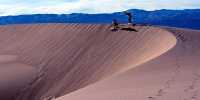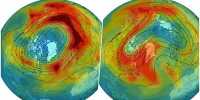According to a recent research published in the journal Science Advances, an asteroid or comet smashing into Earth 58 million years ago created a large impact crater beneath Greenland’s ice sheet. Although it had previously been speculated that the space rock responsible for the crater struck while people inhabited the Earth, fresh evidence suggests that the catastrophe occurred only a few million years after the dinosaur era.
The 31-kilometer (19.3-mile) broad Hiawatha crater rests beneath a kilometer of ice in northwest Greenland and is known as the Hiawatha crater. It was initially discovered in 2015 during a thickness survey of the ice sheet. Initially, charcoal particles found in glacial meltwater were thought to be produced from plant species that lived during the Pleistocene epoch, which ended 11,700 years ago.
Based on these observations, researchers theorized that the Hiawatha crater originated roughly 13,000 years ago, perhaps sparking the Younger Dryas period of global cooling. This scenario fits nicely with the so-called Younger Dryas impact hypothesis, which claims that chunks of a massive, disintegrating space rock slammed the Earth at several areas around 12,800 years ago, triggering a millennium-long period of glaciation.
The authors of this new study looked at sediments in the meltwater that showed unmistakable indicators of being damaged by an asteroid impact to estimate the crater’s real age. This contained sand grains from partly melted rocks and tiny stones bearing “shocked” zircon crystals. The sand was then dated by heating grains with a laser until argon was emitted. They discovered that the rocks from which the sand was made were hit 58 million years ago by studying the various argon isotopes present in their sample.
By determining the rate of uranium decay inside the shocked zircon crystals, it was determined that these, too, were formed 58 million years ago, providing rather solid proof for the crater’s age. “In a statement, research author Michael Storey said, “Dating the crater has been an especially difficult nut to crack.” “I’m confident that we’ve figured out the crater’s true age, which is significantly older than many people imagined,” she says “Added he.
These findings suggest that the Hiawatha asteroid did not impact Earth during the human era and did not contribute to the Younger Dryas. Furthermore, the collision occurred at a different time than a large warming event 56 million years ago, raising issues about the impact’s impact on the world temperature. More research into the nature of the ejecta created by the event, according to the researchers, might “allow direct integration of the impact event with sedimentary climatic proxies.”














